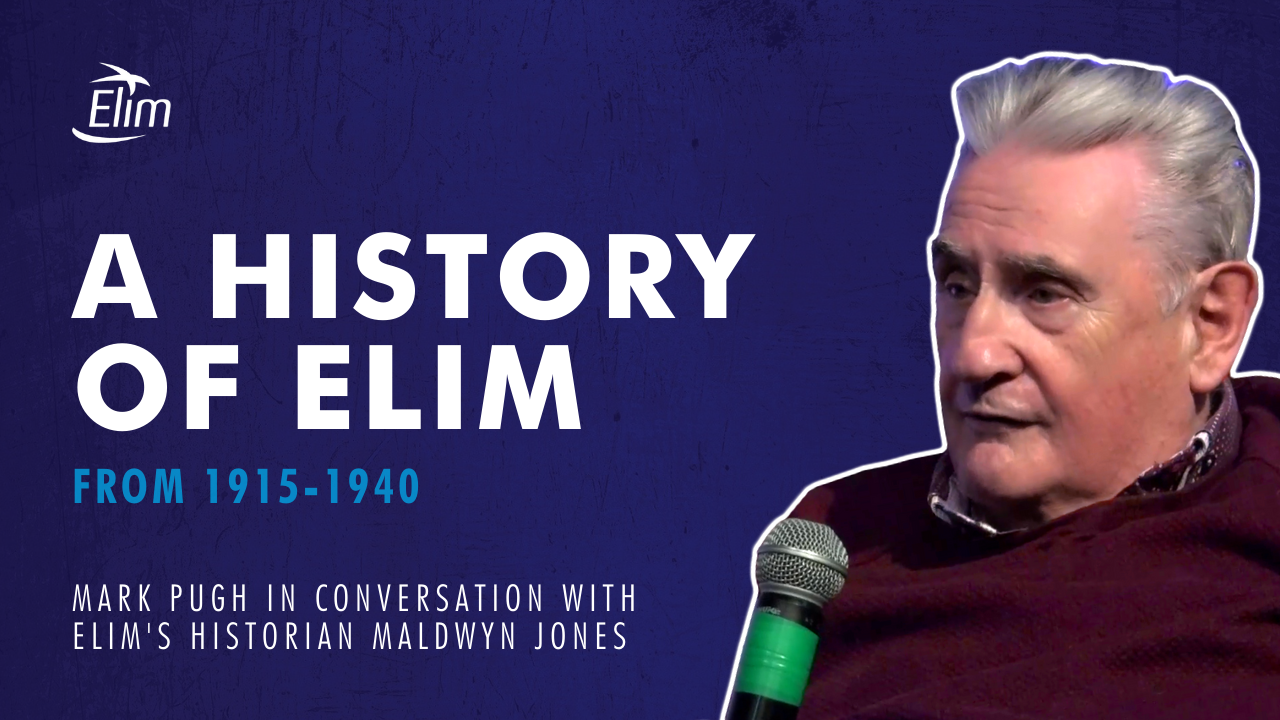
An interview with Elim's historian
Join Elim's historian Maldwyn Jones in conversation with Mark Pugh, for this fascinating and insightful interview about Elim's history from 1915 - 1940.
Recorded to celebrate the launch of Maldwyn's new book 'And they Came to Elim' which is out on 21 May as a paperback and Kindle book at amzn.to/3sGBDJc
Purchase your advance copy directly from Maldwyn Jones.
The Beginnings of the Elim Movement
The Elim movement of churches is over 100 years old and celebrated its centenary in 2015. But how did it start?
Elim’s birth was extraordinary. The year was 1915. It could hardly have been a less promising time as the nation was feeling the full horrors of the First World War.
In Monaghan, Ireland, a small group of young men had invited welsh evangelist George Jeffreys to hold some meetings. Their fervour and faith drew him and, on 7 January 1915, in the Temperance Hall the Elim Evangelistic Band was formed to spread the Christian gospel in the power of the Holy Spirit to Ireland and beyond.
George Jeffreys hailed from Maesteg in South Wales. He had been converted in the 1904 Welsh revival and baptised in the Spirit some three years later. With his older brother Stephen, he had begun to preach a “full gospel” message with significant results.
God blessed his ministry with many converts and a growing number of people were filled with the Holy Spirit and many were miraculously healed in the meetings. This resulted in George being invited to the popular Sunderland Convention in 1913 where he received the invitation to Ireland.
Above images: Elim's centenary was in 2015 and 100 years of Elim were celebrated across the nations.
Quickly other men and women gathered to Jeffreys and the emerging Elim work. Many of them were young, some barely out of their teens. Yet they were caught up in what they believed to be a fresh wave of the Holy Spirit which so many had been praying and believing for.
With no plan to start a denomination, the Elim Team planned campaigns and outreaches in town after town and city after city. This growing group of Pentecostal believers found fresh identity not just in the exciting brand of meetings and methods with which they had been reached for Christ but in their experience of the baptism in the Holy Spirit, attested to by speaking in tongues and in the miracles and healings which were a regular feature of so many of their meetings.
George Jeffreys chose the name Elim for the new movement following the practice in his home of Wales of giving churches biblical names and also after the Elim Mission he had visited in Lytham, Lancashire.
The many Elim converts were often not welcome in other churches. The first Elim Church was opened in 1916 in Hunter Street, Belfast in a former laundry. Soon afterwards, a more suitable building was found in Melbourne Street, Belfast.
This would be the hub of the growing Elim work in Ireland for the next few years. They purchased a large tent to hold evangelistic campaigns, they looked for suitable buildings to gather the new converts and they sought every opportunity to reach people for Christ and pioneer new churches. By 1920, there were 15 Elim Churches in Ireland and 21 recognised Elim ministers.
The Elim Evangel, first published in 1919, began to tell the larger story of what God was doing through these Elim pioneers as well as sharing personal testimonies from many who were converted and healed.
Elim's historic timeline
Elim's timeline spans over 100 years and when we celebrated our centenary, some of the key moments were collected from our archives and brought together in this interactive timeline. It's best viewed full screen, so click here to view a larger version.
Our history matters - raising funds to keep our Pentecostal history alive

Over the last 18 months, Elim and Regents Theological College have become the custodians of four substantial Pentecostal archive collections the Desmond Cartwright archive, the New Frontiers archive, the Tony Cauchi collection, and the Donald Gee Foundation archive
These have been added to the Regents archive study centre, and have proved to be a fascinating resource for people interested in the Elim story and the history of Pentecostalism. They are also important to researchers, journalists, and the Regents students.
With the increasing interest in church history, it's difficult to join a discussion if you come in at the end with no real appreciation of how it started and developed. That's is why Regents Theological College take its responsibility of stewarding the Pentecostal Archives so seriously.
Help us develop the expansion of the Elim archives
Donate online to help us keep Elim's story alive via our Just Giving page here.
Also, spread the word with your church congregations and pass on the link to the Just Giving page.
Enjoy this article? Don’t forget to share